Rear area postal service
Mining companies' mail
During the German occupation of Northern France in World War I, VALENCIENNES served as the headquarters for the Mining Administration (Bergverwaltung). Situated at 104 rue de Famars, the Bergverwaltung oversaw mining activities in the Nord and Pas-de-Calais regions, playing a crucial role in managing resources and regulating correspondence related to mining operations.


Map of mines in the Nord and Pas-de-Calais departments in January 1916, taken from "Die industrie im besetzten Frankreich, 1916". The black line represents the front line at that time. The dotted line is the range limit of Anglo-French artillery.
ANZIN (6th Army) to PERUWELZ (General Government of Belgium, district of TOURNAI), 16th January 1916. Letter weighing 20 g franked at 10 Pf/10 c (rate of 15/12/1914). This letter shows the signature of the examiner, Lieutenant Weigelin.
ANZIN (6th Army) to PERUWELZ (General Government of Belgium, Arrondissement of TOURNAI), 3rd October 1915. Letter franked at 10 Pf/10 c (rate of 15/12/1914) and examined by the Bergverwaltung of VALENCIENNES (stamp "Geprüft", "Bergverwaltung Etappeninspektion 6." and signature of the controller von Oheimb). A new control was carried out by the Imperial Commissioner for the district of TOURNAI (Kaiserliche Zivilkomissar bei dem Kreischef Tournai).
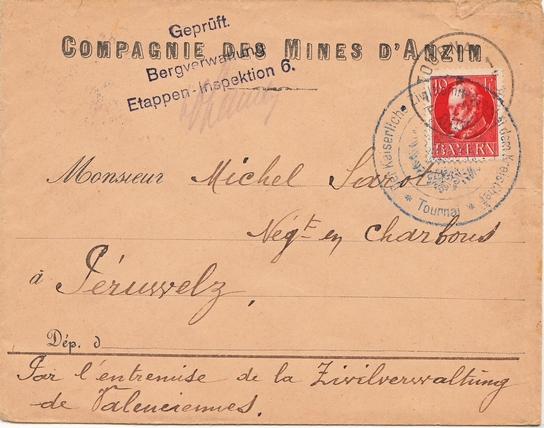

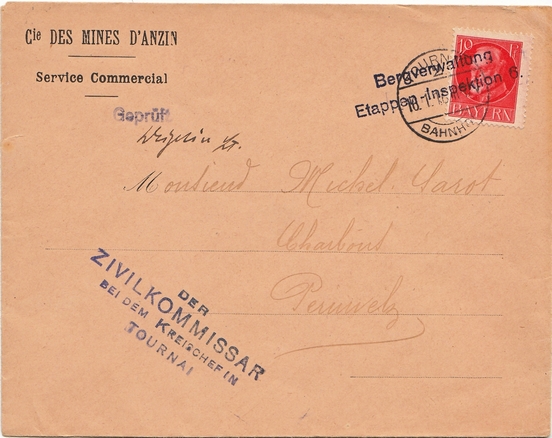

ANZIN (6th Army) to PERUWELZ (General Government of Belgium), 9th July 1916.
Letter up to 40 g franked at 20 Pf/20 c (tariff of 15/12/1914).
Military postal control of the 6th Army and passage through BRUSSELS (Roulette cancellation of the Caisse d'Epargne).
To date, there is no convincing explanation for this diversion via BRUSSELS. Several authors attribute it to the creation of the new 1st Army and the subsequent reorganisation of the Lines of Communication between the 6th and 1st Armies. However, according to certain primary sources preserved in the MUNICH military archives, this explanation is not plausible.
When the 1st Army was formed in July 1916, it initially operated under the 2nd Army's Lines of Communication Inspectorate. By late August 1916, discussions had begun regarding a permanent location for the 1st Army's Inspectorate, with CAMBRAI, DENAIN, and MAUBEUGE being considered as potential sites.
However, in a directive dated 9 September 1916 (Bildung der Etappeninspektion 1. 1.9.1916. A.O.K. 6 Ic Nr. 65276), the Intendant General ordered the relocation of the 6th Army's Lines of Communication Inspectorate to TOURNAI, while VALENCIENNES was designated as the new headquarters for the 1st Army. This change was set to take effect on 1 October 1916.
It is therefore unlikely that the formation of the 1st Army and its Lines of Communication Inspectorate before 1 October 1916 had any impact on the examination or transport of mining company mail.
Notably, this mail was consistently examined by the Bergverwaltung, as evidenced by the presence of signatures or initials from examiners on certain letters. The signatures of Lieutenant von Oheimb, who signed as "v Oh" or "v O", and Lieutenant Weizelin (or Weigelin), who signed either with his full name or with a capital "W", have been documented.
October 1916 - 18 April 1917: The Bergverwaltung within the 1st Army.
Although the Bergverwaltung was already within the 1st Army’s Lines of Communication area from 1 October, it was not officially attached to its Inspectorate until 4 October, rather than on 1 October—the date of the Lines of Communication area change.
A new Bergverwaltung stamp was introduced, which is known to have been in use for a brief period from 10 to 30 October 1916.
VALENCIENNES to MONCHECOURT (1st Army). Letter controlled by the Bergverwaltung and the 1st Army. The Bergverwaltung applied its unit stamp "Bergverwaltung Valenciennes Deutsche Feldpost 292" in addition to its control stamp, which is rather unusual.
This is the only known case of this type of use.
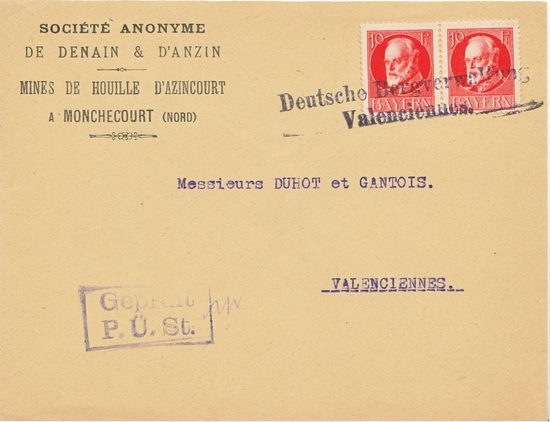

AZINCOURT mines towards VALENCIENNES.
Postal control by the Bergverwaltung (stamp "Deutsche Bergverwaltung") and military control by the Postüberwachungsstelle 39 (stamp "Geprüft P.Ü.St.").
19 April 1917 - End of September 1918: The Bergverwaltung within the 2nd Army.


ANZIN (2nd Army) to PERUWELZ, 1st October 1917. Administrative control (stamp "Deutsche Bergverwaltung") and military postal control (stamp "Geprüft P.Ü.St").
ANZIN (2nd Army) to QUIEVRECHAIN (2nd Army). Letter controlled by the Bergverwaltung of VALENCIENNES (stamp "Militär-Bergverwaltung Nr. 1 Deutsche Feldpost 45"). This mark appeared in January 1918.
Here is what the book "Völkerrecht im Weltkrieg 1914-1918" published in 1927 tells us: "The German mining administration in the coalfields of northern France was a department of the Lines of Communication Inspectorate (6 et seq.) until the autumn of 1916, then an independent administration under the authority of the Intendant General of the Army [Generalintendant des Feldheeres], later a representative of the Quartermaster General [Beauftragter des Generalquartiermeisters] and finally (1918) directly subordinate to the Quartermaster General [Generalquartiermeister].
The mining administration for the coalfields of northern France had its official headquarters in Valenciennes and was initially called "Bergverwaltung Valenciennes", then "Militär Bergverwaltung 1".
A similar administration, called "Militärbergverwaltung 2", with its official headquarters in Mons, existed for the Belgian mines in the Mons district.
In the autumn of 1917, these two administrations were merged to form the "Militär Bergwerksdirektion" in Valenciennes, in order to regulate personnel matters, material supplies, etc. in a uniform manner. The Militär Bergwerksdirektion, with its two mining administrations, was budgeted by the Prussian War Ministry.
The administration did not have purely military functions; its task was rather to supervise the mines. [...] The operation and administration of French mines, on the other hand, were always managed by the French mining administrations themselves, with their own staff and on their own account. "
Control of the mail by this Administration was based essentially on accounting control of the quantities of coal to be delivered by the mines.
October 1914 - End of September 1916: The Bergverwaltung within the 6th Army.
The mining administration relocated to VALENCIENNES in October 1914.
There is no record of any mail being examined by the mining administration before 9 September 1915. Prior to that date, it remains unclear how the mining company's mail was processed or whether it was even permitted to circulate. In fact, civilian mail—except for prisoner of war correspondence—was prohibited. However, on 29 May, Order VI No. 19061 issued by the 6th Army Lines of Communication Inspectorate exceptionally authorised commercial mail. A subsequent order, dated 13 September 1915 (No. 31207/1669), specified the following:
"Letters from commercial and industrial firms in the Lines of Communication area may be forwarded only if they concern orders, etc., in which the Army has a definite interest. When submitting such letters to the Inspectorate, Lines of Communication Commanders should always indicate whether there is such an interest and whether they are in favour of sending them".

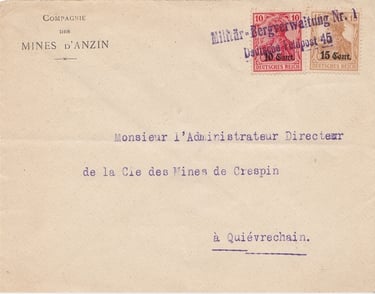
The postmark Deutsche Bergverwaltung (without Valenciennes) remained in use until 17 October 1917.
Subsequently, Deutsche Bergverwaltung 1 was renamed Militär-Bergverwaltung 1. The exact date of this change is unknown, but it appears as Militär-Bergverwaltung Nr. 1 in the directory of Kommandantur No. 158 (Valenciennes) on 1 January 1918.
The Bergverwaltung examination stamp was updated to Militär-Bergverwaltung Nr. 1 Deutsche Feldpost 45 and is documented between 31 January and 5 February 1918. However, it is likely that it continued to be used beyond February 1918.
On 16 January 1917, the Ministry of War published Order No. 54. This decree stipulated that from 15 February 1917: "All information relating to theatres of operations, attachment to armies, army groups or army detachments, army corps, divisions, and brigades is prohibited in addresses". This decree mainly affected troops and military services at the front; Lines of Communication troops or services were not immediately affected.
On 10 May 1917, the Director of the Army Post Office suggested replacing the location of certain services, such as bank supervision offices, with a number.
On 24 May 1917, the Generalquartiermeister issued a decree ordering, among other things, the change of name of the Mining Administrations. The VALENCIENNES Mining Administration was renamed "Deutsche Bergverwaltung 1 Deutsche Feldpost 45".
This decree had no immediate effect, as the "Deutsche Bergverwaltung Valenciennes" stamp was known until 20 June 1917. The word "Valenciennes" were probably removed at the end of June.
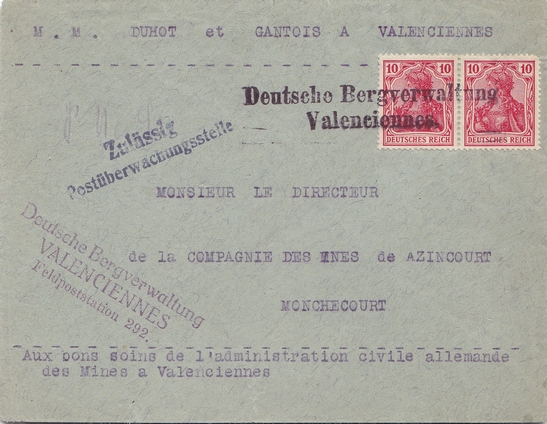

The Bergverwaltung cachet was replaced fairly quickly at the beginning of November by the Deutsche Bergverwaltung Valenciennes cachet. The earliest known date of this mark is 8 November 1916.
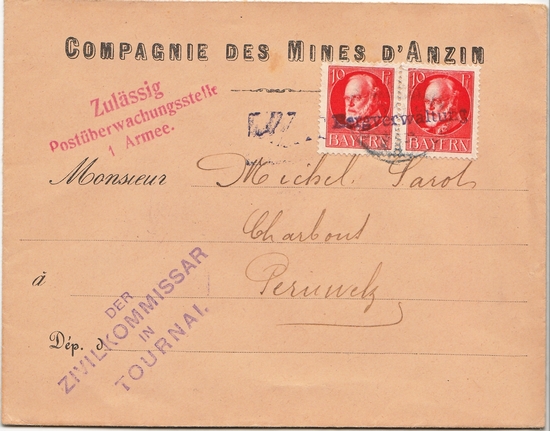

Following the withdrawal of German troops behind the Siegfried Line and the British offensives around ARRAS, the Supreme Command decided on 12 April 1917 to reorganise the northern sector of the front and disband the 1st Army. On 19 April 1917, Lines of Communication Inspector Franke issued a notice announcing that the Kommandantur districts of CAMBRAI, VALENCIENNES, ARTRES, SOLESMES, LE QUESNOY and BAVAY were to be attached to the 2nd Army's Lines of Communication.
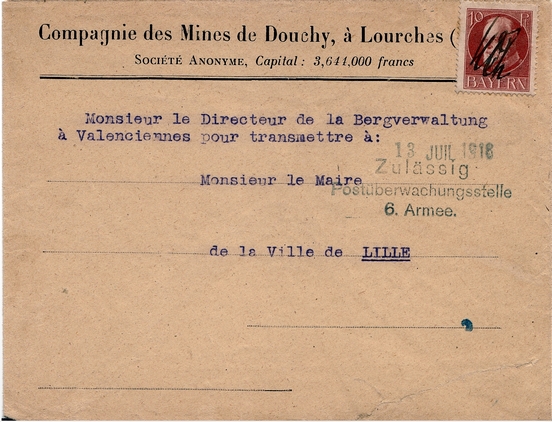

LOURCHES to LILLE (6th Army). Letter examined by the Bergverwaltung (initialled 'v Oh'). Postal control carried out on 13th July 1916 by the 6th Army postal control centre (stamp "Zulässig Postüberwachungsstelle 6. Armee").

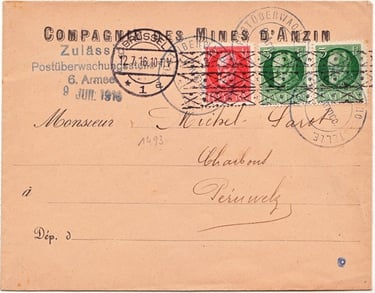
ANZIN (1st Army) to PERUWELZ (Belgian General Government, district of ATH), 10 October 1916.
Letter up to 40 g franked at 20 Pf/25 c. Following the departure of the 6th Army, the examination stamp "Bergverwaltung Etappeninspektion 6." was replaced by "Bergverwaltung".
Like the letter mentioned above, the Bergverwaltung Etappeninspektion 6. cachet was certainly not a control stamp but rather a service stamp used for censoring mining company mail.
Its relationship with the Geprüft postmark on mail appears to be quite random. Nevertheless, we know that the Bergverwaltung Etappeninspektion 6 mark was in use until mid-May 1916. From that point onwards, except for three letters dated 8, 12, and 18 August 1916, mail from the mining companies no longer bore this stamp, but instead carried only that of the 6th Army's postal control centre.
Furthermore, mail destined for the territory of the Belgian General Government was now systematically routed through the main post office in BRUSSELS (BRUSSELS 1), where frankings were cancelled by a roulette stamp, as they were deemed to be insufficiently or not at all cancelled.
Recently, another control stamp was discovered that is very similar to the previous one, but with a slightly different wording. This stamp is labelled "Militär-Bergverwaltung Nr. 1 Feldpoststation 45".
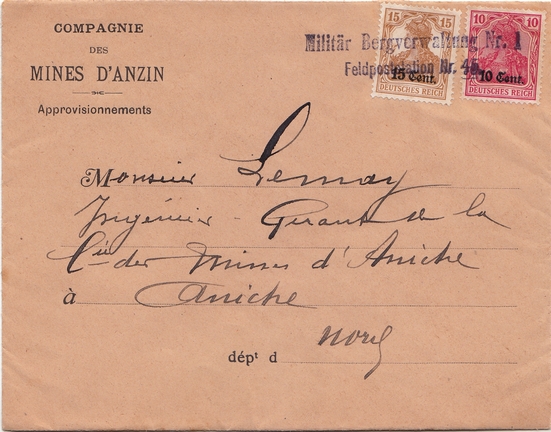

ANZIN to ANICHE (2nd Army).
Administrative control (stamp "Militär-Bergverwaltung Nr. 1 Feldpoststation 45"). This is the only letter known to date with this mark, which uses the term "Feldpoststation" instead of "Feldpost".
Unfortunately, this letter is undated. However, in the archives of the Mining History Centre in LEWARDE, there is a letter bearing the same postmark, dated 9 March 1918.
The control stamps Deutsche Bergverwaltung Nr. 1 Deutsche Feldpost 45 and Militär-Bergverwaltung Nr. 1 Feldpoststation 45 likely coexisted for a brief period.
Finally, it appears that from April or May 1918, the Bergverwaltung was served by Feldpoststation No. 34, which was also based in Valenciennes. It was probably at this time that the "45" was removed from the postmark.
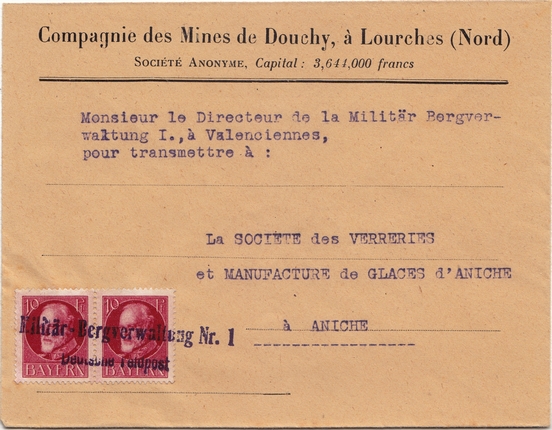

DOUCHY to ANICHE (2nd Army). Administrative control (stamp "Militär-Bergverwaltung Nr. 1 Deutsche Feldpost..."). In April/May 1918, the Bergverwaltung of VALENCIENNES ceased to be served by Feldpoststation 45. The "45" was therefore removed from the postmark.
Focus on the period October 1916 - June 1917.
To conclude this section, it is worth examining a particularly complex period to analyse. From the beginning of the 1st Army’s tenure and for several months thereafter, mail from the mines was routed to Péruwelz via Tournai.
In addition to the control stamps applied by the Bergverwaltung and later by the 1st Army's postal control centre upon departure, this mail also bore the control stamps of the Tournai Civil Commissariat and the 6th Army's postal control centre upon arrival.


ANZIN (1st Army) to PERUWELZ, 8th November 1916. In November 1916, a new control stamp was introduced by the Bergverwaltung ("Deutsche Bergverwaltung Valenciennes" stamp).
Double military control:
1st Army: "Zulässig Postüberwachungsstelle 1. Armee".
6th Army "Zulässig Postüberwachungsstelle 6. Armee" + "Postüberwachungsstelle Geprüft Tourmai".
Before the transfer of the Lines of Communication area between the 1st and 6th Armies, the TOURNAI military district comprised the Belgian districts of TOURNAI and ATH.
When Tournai became the capital of the Lines of Communication area for the 6th Army, the ATH military district was established, incorporating the district of ATH along with certain communes from the TOURNAI district, such as PERUWELZ, which had not been included in the new Lines of Communication area.
The district chief relocated to ATH, while the civil commissioner remained in TOURNAI as the representative of the president of the civil administration of the province of Hainaut.
As a result, mail from the mines to PERUWELZ should no longer have been checked by the civil commissioner in TOURNAI, but instead by the civil commissioner in ATH. Furthermore, this mail should not have been routed through TOURNAI but rather sent directly from the Bergverwaltung or the 1st Army's postal control centre to ATH.
There is no definitive explanation for this discrepancy, but in my view, it must have been due to misdirection.
Indeed, there are letters addressed to PERUWELZ that were routed via ATH and checked locally by the civil commissioner, while during the same period, other letters were still directed through TOURNAI.
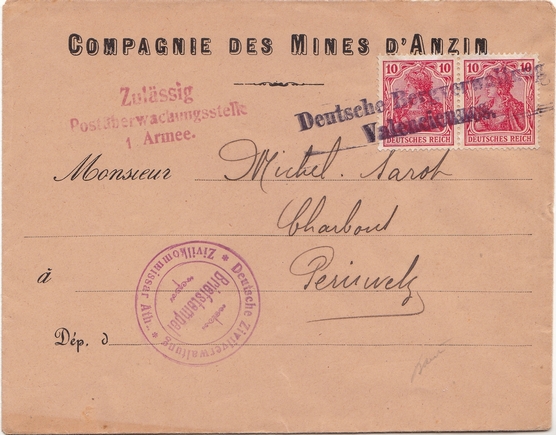

Letter from ANZIN to PERUWELZ (16 December 1916). Control by the Mining Administration.
Military postal control of the 1st Army and, on arrival, control by the civilian commissioner of ATH.
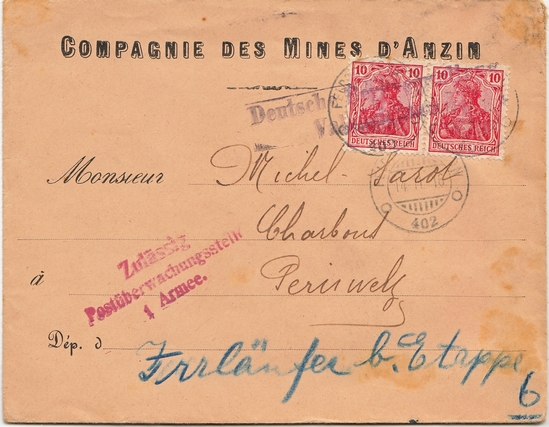

ANZIN (1st Army) to PERUWELZ, 14th November 1916. This letter arrived at TOURNAI where it was marked "Irrläufer bei Etappe 6. (missent to the L. of. C. of the 6th Army).

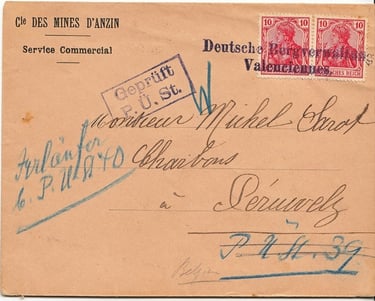
ANZIN (2nd Army) to PERUWELZ (Belgian General Government, district of ATH), June 1917. Letter examined by the Bergverwaltung of VALENCIENNES and sent by mistake to Postüberwachungsstelle n° 40 (6th Army) instead of Postüberwachungsstelle n° 39 (2nd Army). When it arrived in TOURNAI, it was returned to VALENCIENNES (marked "Irrläufer b. P.Ü.St 40"). After a military postal check (stamp "Geprüft P.Ü.St."), it was directed to ATH.
We do not know why so few letters from this period bear the wording "Irrläufer" (Missent). Nor do we know why sometimes the 6th Army agreed to examine certain letters to PERUWELZ and other times not, as in the case of this letter.
From June 1917, we find letters which more systematically bear the stamp of the civil commissioner of ATH.
In addition, we know of at least 3 letters from the mining company of ANZIN sent via TOURNAI with the words "Irrläufer b. Etappe 6." or "Irrläufer b. P.Ü.". St. 40." (missent to Lines of Communication 6 or missent to Postüberwachungsstelle 40).
Late September 1918 - 12 October 1918: The Bergverwaltung within the 17th Army.
The 2nd Army withdrew from VALENCIENNES at the beginning of October 1918. VALENCIENNES was subsequently incorporated into the Lines of Communication area and later fell within the 17th Army’s area of operations. This marked the beginning of the destruction of the mining installations.
On 9 October, the directors and other French executives of the mining companies, along with their families and main archives, were relocated to LIEGE.
On 12 October, Bergverwaltung 1 and the Bergwerksdirektion ceased their activities in VALENCIENNES, with the former relocating to LIEGE and the latter to MONS. Unfortunately, no letters from this period are known to have survived.

